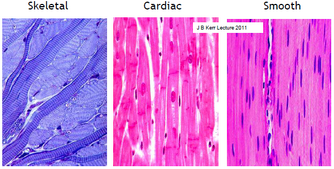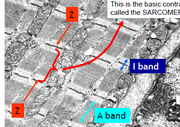Lecture Details[]
Jeff Kerr; Week 6 MED1011; Anatomy
Lecture Content[]

Skeletal muscle is bundles of parallel cylinders, myofibrils are the smallest, 1mm to 20cm. Myofibrils are fused indivdual cells ('multinucleated'). Cells are striated. Cardiac cells are branching cylinders (cardiomyocytes), 50-100um. Joined end to end with single nuclei. Cells striated. Smooth muscle cells surround many hollow organs, spindle shaped individual cells from 20-200um, not striated. Skeletal can regenerate a limited amount, cardiac cannot regenerate, and smooth muscle readily regenerates. Not all skeletal muscle is anchored to bone/tendon, some bundles interlace with each other. Skeletal muscle has peripheral nuclei.

Basic contractile units are known as sarcomeres. Z bands indicate the ends of the sarcomere. I bands are not overlapped, A bands are overlapped. Cardiac muscle cells are branched and connect with gap junctions. They have central nuclei. Smooth muscle is found in the walls of the gut, blood vessels, hollow and solid organs. Contraction is slow and not under voluntary control. It has no striations but still relies on actin/myosin interaction for movement. Cytoplasmic density of these cells is due to this interaction.
In the PNS there are motor and sensory fibres; within motor there are visceral (ANS) and somatic, within visceral there are parasympathetics and sympathetics. Neurons can be multipolar, bipolar or pseudounipolar. Motor neurons are efferent, sensory are afferent, interneurons create networks. A cluster of cell bodies is a ganglion. From cell bodies there are dendrites, also axon hillock. A typical neuron consists of cell body (soma, perikaryon), multiple dendrites and one axon. Many nerve axons are covered with myelin. Nodes of Ranvier exist between myelin sheaths. Myelin is made by Schwann cells. Nerve fascicles are held together with connective tissue. Conduction of nerves is about 100m/sec. Unmyelinated nerves are surrounded by Schwann cells but not myelin, conduction is about 1m/second.
Nerve tissue within the CNS has neurons with cell body, long processes, used for impulses and found in the brain, spinal cord, PNS. Neuroglia have special cell processes, are for metabolic/physical support and are also in brain, spinal cord, PNS. Grey matter of brain contains cell bodies, white matter is just axons and dendrites but no cell bodies. CSF is made in ventricles of the brain by the chorioid plexus, about 500mL made each day, circulates and is reabsorbed by the meninges. Cerebral cortex divided to 6 histological strata, and into vertical columns. Cerebellum has two hemispheres, responsible for proprioception, coordination of motor and sensory integration to allow control of muscle activity. Can be large scale movement or fine muscle control. Purkinje cell has giant neurons.
Neuroglia are 10 times more abundant than neurons in the mammalian brain, surrounds neuron cell bodies and axonal and dendritic processes. Nervous tissue has no intracellular matrix, glial cells provide a microenvironment suitable for neuronal activity. CNS has astrocytes for metabolic support, oligodendrocytes for myelin, microglia are macrophages. PNS has Schwann cells. Astrocytes are star shaped, bind neurons to capillaries and to pia mater (innermost layer of meninges). Fibrous astrocytes have few long processes and are found in white matter, protoplasmic astrocytes have many short branched processes and are found in grey matter. They form part of the blood brain barrier, influence neuronal survival and activity, and communicate with one another via gap junctions. Oligodendrocytes produce myelin sheath in the CNS, can branch and produce myelin to more than one axon.
Sensory nerves are dorsal horns and motor are ventral. Non-neuronal parts of grey matter are known as the neuropil.